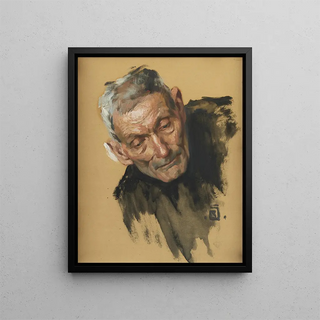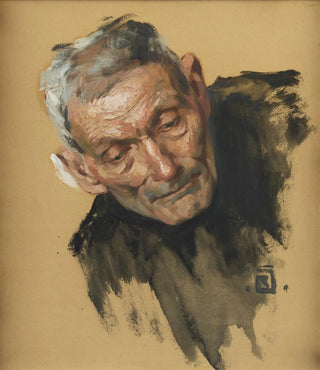Art print | Study of a man's head - Robert Seuffert


View from behind

Frame (optional)
Robert Seuffert's artwork "Study of a Man's Head" presents itself as an open window into human intimacy, a delicate exploration of the emotions and thoughts that inhabit every face. This piece, both simple and complex, embodies the very essence of artistic representation, where each line, each shadow is carefully crafted to evoke psychological depth. By contemplating this work, the viewer is invited to dive into a universe where time seems suspended, where the expressions of the human figure reveal a universal condition. This masterpiece is not merely a simple representation; it is an invitation to reflect on our own humanity.
Style and uniqueness of the work
Robert Seuffert's style is distinguished by his ability to capture the essence of his subjects with great finesse. In "Study of a Man's Head," the artist uses flowing lines and subtle nuances to create a portrait that goes beyond mere physical appearance. Every detail, whether it be the eyes, the mouth, or the contours of the face, is treated with particular attention, revealing a sensitivity that transcends technique. Light and shadow play a crucial role, adding an almost sculptural dimension to the composition. This contrast allows for heightened emotional expression, making the subject's face both familiar and mysterious. Thus, Seuffert's work stands out for its ability to evoke deep feelings while remaining rooted in a realistic aesthetic.
The artist and his influence
Robert Seuffert, an emblematic figure of the early 20th century, managed to carve out a prominent place in the art world thanks to his innovative approach and unique vision. Influenced by the great masters of painting, he developed a style that is uniquely his own, blending tradition and modernity. His work was marked by a constant search for expression, a quest for inner truth reflected in his portraits. Seuffert also had a significant impact on his contemporaries, inspiring many artists to explore the subtleties of human psychology through the prism of the face. By emphasizing emotions

Matte finish

View from behind

Frame (optional)
Robert Seuffert's artwork "Study of a Man's Head" presents itself as an open window into human intimacy, a delicate exploration of the emotions and thoughts that inhabit every face. This piece, both simple and complex, embodies the very essence of artistic representation, where each line, each shadow is carefully crafted to evoke psychological depth. By contemplating this work, the viewer is invited to dive into a universe where time seems suspended, where the expressions of the human figure reveal a universal condition. This masterpiece is not merely a simple representation; it is an invitation to reflect on our own humanity.
Style and uniqueness of the work
Robert Seuffert's style is distinguished by his ability to capture the essence of his subjects with great finesse. In "Study of a Man's Head," the artist uses flowing lines and subtle nuances to create a portrait that goes beyond mere physical appearance. Every detail, whether it be the eyes, the mouth, or the contours of the face, is treated with particular attention, revealing a sensitivity that transcends technique. Light and shadow play a crucial role, adding an almost sculptural dimension to the composition. This contrast allows for heightened emotional expression, making the subject's face both familiar and mysterious. Thus, Seuffert's work stands out for its ability to evoke deep feelings while remaining rooted in a realistic aesthetic.
The artist and his influence
Robert Seuffert, an emblematic figure of the early 20th century, managed to carve out a prominent place in the art world thanks to his innovative approach and unique vision. Influenced by the great masters of painting, he developed a style that is uniquely his own, blending tradition and modernity. His work was marked by a constant search for expression, a quest for inner truth reflected in his portraits. Seuffert also had a significant impact on his contemporaries, inspiring many artists to explore the subtleties of human psychology through the prism of the face. By emphasizing emotions






